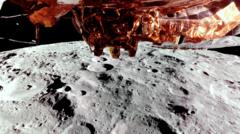Recent findings indicate that oxygen, a critical element for life, may be generated in extreme underwater environments, prompting researchers to explore the implications for both Earth and extraterrestrial ecosystems.
"Exploration of 'Dark Oxygen' Could Transform Our Understanding of Life Beyond Earth"

"Exploration of 'Dark Oxygen' Could Transform Our Understanding of Life Beyond Earth"
A deep-sea mission aims to investigate how oxygen is produced in ocean depths, potentially revealing new pathways for life on other planets.
In a groundbreaking initiative, researchers are set to delve into Earth's deepest oceans to explore a phenomenon that could transform our understanding of potential life on other planets. Their inquiry is sparked by a startling discovery that metal nodules resting on the dark ocean floor can generate oxygen, a process previously thought to occur solely through sunlight-driven photosynthesis.
Leading the mission, Professor Andrew Sweetman stated that the team has already initiated dialogues with experts at NASA, who share the belief that this 'dark oxygen' could dramatically alter our perceptions of life-sustaining processes on celestial bodies devoid of sunlight. "We want to go out there and figure out what exactly is going on," Sweetman remarked, emphasizing the scientific community's eagerness to investigate this uncharted territory.
The findings, which have stirred debate within the scientific community, came from expeditions in a deep-sea region between Hawaii and Mexico, where sensors revealed unexpected increases in oxygen levels more than five kilometers below the surface. This discovery challenges long-held beliefs and underscores the potential for microbial life to thrive in dark ocean ecosystems.
While further probing into these depths, the researchers will employ remote-operated submersible technologies to study sites exceeding 10 kilometers in depth. Sweetman expressed confidence that evidence of dark oxygen generation would be discovered elsewhere, pointing to the possibility of similar processes occurring on distant moons and planets.
However, the implications of this research extend beyond mere exploration. As seabed mining companies eye the valuable metals found in these underwater nodules, there is rising concern about the environmental consequences of harvesting these resources. Many marine scientists have raised alarms, urging a reevaluation of mining practices, with over 900 experts publicly advocating a halt until further ecological understanding can be achieved.
As part of their exploration, the team will conduct experiments to prove definitively whether these metallic structures indeed produce oxygen. Critics of the initial findings have questioned the scientific rigor of the study, suggesting the oxygen levels observed may have been artifacts of the sampling process rather than a genuine biological function.
Amidst growing demands for sustainable approaches to resource extraction, Professor Sweetman noted, "Before we do anything, we need to understand the deep-sea ecosystem." The outcome of this research could not only illuminate the mysteries of Earth's dark oceans but also significantly reshape our approach to seeking life beyond our planet.
Leading the mission, Professor Andrew Sweetman stated that the team has already initiated dialogues with experts at NASA, who share the belief that this 'dark oxygen' could dramatically alter our perceptions of life-sustaining processes on celestial bodies devoid of sunlight. "We want to go out there and figure out what exactly is going on," Sweetman remarked, emphasizing the scientific community's eagerness to investigate this uncharted territory.
The findings, which have stirred debate within the scientific community, came from expeditions in a deep-sea region between Hawaii and Mexico, where sensors revealed unexpected increases in oxygen levels more than five kilometers below the surface. This discovery challenges long-held beliefs and underscores the potential for microbial life to thrive in dark ocean ecosystems.
While further probing into these depths, the researchers will employ remote-operated submersible technologies to study sites exceeding 10 kilometers in depth. Sweetman expressed confidence that evidence of dark oxygen generation would be discovered elsewhere, pointing to the possibility of similar processes occurring on distant moons and planets.
However, the implications of this research extend beyond mere exploration. As seabed mining companies eye the valuable metals found in these underwater nodules, there is rising concern about the environmental consequences of harvesting these resources. Many marine scientists have raised alarms, urging a reevaluation of mining practices, with over 900 experts publicly advocating a halt until further ecological understanding can be achieved.
As part of their exploration, the team will conduct experiments to prove definitively whether these metallic structures indeed produce oxygen. Critics of the initial findings have questioned the scientific rigor of the study, suggesting the oxygen levels observed may have been artifacts of the sampling process rather than a genuine biological function.
Amidst growing demands for sustainable approaches to resource extraction, Professor Sweetman noted, "Before we do anything, we need to understand the deep-sea ecosystem." The outcome of this research could not only illuminate the mysteries of Earth's dark oceans but also significantly reshape our approach to seeking life beyond our planet.


















